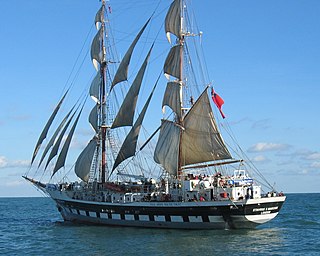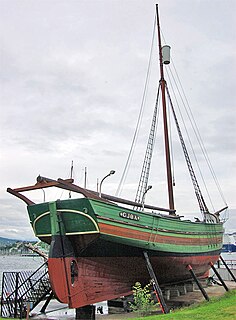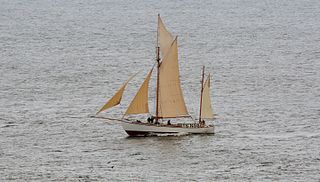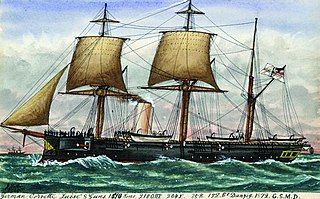
A schooner is a type of sailing vessel defined by its rig: fore-and-aft rigged on all of 2 or more masts and, in the case of a 2 masted schooner, the foremast generally being shorter than the mainmast. A common variant, the topsail schooner also has a square topsail on the foremast, to which may be added a topgallant and other square sails, but not a fore course, as that would make the vessel a brigantine. Many schooners are gaff-rigged, but other examples include Bermuda rig and the staysail schooner.

A brigantine is a two-masted sailing vessel with a fully square-rigged foremast and at least two sails on the main mast: a square topsail and a gaff sail mainsail. The main mast is the second and taller of the two masts.

A brig is a sailing vessel with two square-rigged masts. During the Age of Sail, brigs were seen as fast and maneuverable and were used as both naval warships and merchant vessels. They were especially popular in the 18th and early 19th centuries. Brigs fell out of use with the arrival of the steam ship because they required a relatively large crew for their small size and were difficult to sail into the wind. Their rigging differs from that of a brigantine which has a gaff-rigged mainsail, while a brig has a square mainsail with an additional gaff-rigged spanker behind the mainsail.

A barque, barc, or bark is a type of sailing vessel with three or more masts having the fore- and mainmasts rigged square and only the mizzen rigged fore and aft. Sometimes, the mizzen is only partly fore-and-aft rigged, bearing a square-rigged sail above.

A tall ship is a large, traditionally-rigged sailing vessel. Popular modern tall ship rigs include topsail schooners, brigantines, brigs and barques. "Tall ship" can also be defined more specifically by an organization, such as for a race or festival.

Gorch Fock I is a German three-mast barque, the first of a series built as school ships for the German Reichsmarine in 1933.

Fram ("Forward") is a ship that was used in expeditions of the Arctic and Antarctic regions by the Norwegian explorers Fridtjof Nansen, Otto Sverdrup, Oscar Wisting, and Roald Amundsen between 1893 and 1912. It was designed and built by the Scottish-Norwegian shipwright Colin Archer for Fridtjof Nansen's 1893 Arctic expedition in which the plan was to freeze Fram into the Arctic ice sheet and float with it over the North Pole.

A barquentine or schooner barque is a sailing vessel with three or more masts; with a square rigged foremast and fore-and-aft rigged main, mizzen and any other masts.

The Fridtjof Nansen-class frigates are a class of frigates that are the main surface combatant units of the Royal Norwegian Navy. The ships are named after famous Norwegian explorers, with the lead ship of the class bearing the name of Fridtjof Nansen, the Norwegian scientist, explorer and humanitarian. Five ships were ordered from Spanish shipbuilder Bazan. The total projected cost for all five ships is 21 billion kr. As of November 2018, four are in active service and one has sunk and been decommissioned.

Stavros S Niarchos is a British brig-rigged tall ship, now renamed "Sunset". She was previously owned and operated by the Tall Ships Youth Trust (TSYT). She was primarily designed to provide young people with the opportunity to undertake voyages as character-building exercises, rather than pure sail-training. She was also used for adult voyages and holidays, which helped subsidise the operation of the ship.

Gjøa was the first vessel to transit the Northwest Passage. With a crew of six, Roald Amundsen traversed the passage in a three-year journey, finishing in 1906.

PNS Rah Naward is a sail training ship of the Pakistan Navy. She was commissioned in 2001 as Prince William for the Tall Ships Youth Trust and sold in 2010 to the Pakistan Navy and renamed Rah Naward.

Alexander von Humboldt is a German sailing ship originally built in 1906 by the German shipyard AG Weser at Bremen as the lightship Reserve Sonderburg. She was operated throughout the North and Baltic Seas until being retired in 1986. Subsequently, she was converted into a three masted barque by the German shipyard Motorwerke Bremerhaven and was re-launched in 1988 as Alexander von Humboldt. In 2011 the ship was taken off sail-training and sent to the Caribbean for the charter business, then she was converted to a botel. Her sailing days are over for now and she is currently stationed in Bremen, Germany

Gauss was a ship built in Germany specially for polar exploration, named after the mathematician and physical scientist Carl Friedrich Gauss. Purchased by Canada in 1904, the vessel was renamed CGS Arctic. As Arctic, the vessel made annual trips to the Canadian Arctic until 1925. The ship's fate is disputed among the sources, but all claim that by the mid-1920s, the vessel was out of service.

Tradewind is a Dutch topsail schooner. She was built in the Netherlands in 1911 as a herring lugger named Sophie Theresia.

The Nautilus class was a pair of minelaying cruisers built by the Imperial German Navy. Nautilus was laid down in 1905 and completed by 1907, and SMS Albatross was laid down in 1907, and completed in 1908. Both ships were built by the AG Weser shipyard in Bremen, but to slightly different designs. Nautilus had a clipper bow, while Albatross had a bow similar to contemporary German light cruisers. The ships were armed with a battery of 8.8 cm (3.5 in) guns and had a capacity of 168–288 naval mines.

The Tall Ships' Races are races for sail training "tall ships". The races are designed to encourage international friendship and training for young people in the art of sailing. The races are held annually in European waters and consists of two racing legs of several hundred nautical miles, and a "cruise in company" between the legs. Over one half (fifty-percent) of the crew of each ship participating in the races must consist of young people.

Wyvern is a 60-foot (18 m) open sea sailing ship operated by Stavanger Maritime Museum. The ship was designed by Colin Archer on a commission from British-born Frederick Croft and was launched on 10 August 1897. She sailed under the German flag from 1909. The Norwegian newspaper editor Rolf Thommessen bought her in 1924 and renamed her Havfruen III. This name was kept by the English owners, Anne and Terrence Carr, who acquired her in 1947 and sold her to Christian-Frederick Mattner in 1970--who renamed her to the original 'Wyvern'.She was contracted for sale to a Norwegian consortium for £ 50 000 //of which £30 000 is still owed// after having been hijacked from San Antonio Ibiza.
HMS Constant was an Archer– class gun-brig of the Royal Navy, built for service against the French during the French Revolutionary and Napoleonic Wars. In service from 1801, she was variously stationed in English home waters, the Baltic, the Caribbean and off the coast of Spain, and was responsible for the capture of at least seven enemy vessels during her fifteen years at sea.

SMS Luise was a steam corvette of the German Kaiserliche Marine. She was the second member of the Ariadne class, which included two other ships, Ariadne and Freya. Ordered as part of a large naval expansion program after the Austro-Prussian War, she was laid down in 1871 during the Franco-Prussian War. She was launched in December 1872 and completed in June 1874. Luise was a small vessel, armed with a battery of just eight guns.






















